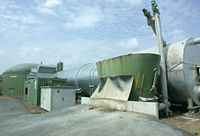
Photo from wikipedia
In the present study, a combined technology for energetic brewery spent grain (BSG) use in co-digestion with sewage sludge (SS) was presented. A holistic approach that includes the impact of… Click to show full abstract
In the present study, a combined technology for energetic brewery spent grain (BSG) use in co-digestion with sewage sludge (SS) was presented. A holistic approach that includes the impact of co-substrates and their carriers on the anaerobic digestion (AD) process, and the energetic aspects, was involved. Prior to AD, BSG was pretreated involving the hydrodynamic cavitation (HC); two different carriers were applied: MPW (municipal pre-settled wastewater) and mature landfill leachate (MLL). An orifice plate with a conical concentric hole of 3/10 mm (inlet/outlet diameter) was applied as cavitation device. The initial pressure was 7 bar and the number of recirculation passes through the cavitation zone was 30. The AD experiments were performed in semi-flow reactors, under mesophilic conditions at HRT of 20 and 21 d. In both co-digestion series, the constant co-substrate dose of 6% v/v was adopted. In the presence of cavitated BSG and MPW, a significant increase in biogas/methane production was provided as compared to SS mono-digestion, with the related improvement in kinetic constant by 3.5%. The average biogas yield was 0.48 ± 0.03 m3 kg-1 VS added, while in the control run 0.41 ± 0.03 m3 kg-1 VS added. Using cavitated BSG and MLL, such a beneficial effect was not observed. In both co-digestion series, slightly lower VS removal (as for the control) and stable process performance occurred. Moreover, the improved energy balance was provided. Due to the technological aspects, only co-digestion of cavitated BSG and MPW with SS is recommended for implementation into a full-scale.
Journal Title: Waste management
Year Published: 2021
Link to full text (if available)
Share on Social Media: Sign Up to like & get
recommendations!